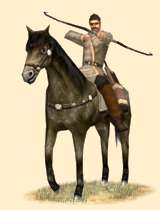Jämsya Yukhuna Duna Purma (Yuezhi Horse Archers)
 |
Weapons | Defence | Mental | ||||||
|---|---|---|---|---|---|---|---|---|---|
| Primary | Secondary | Armour: | 0 | Morale: | 9 | ||||
| Type: | none | sword | Shield: | 0 | Discipline: | normal | |||
| Attack: | 5 | 7 | Skill: | 9 | Training: | untrained | |||
| Charge: | 12 | 12 | Recruitment | Other | |||||
| Lethality: | 1 | 0.13 | Soldiers: | 25 | Hit Points: | 1 | |||
| Range: | 198 | 0 | Cost: | 1209 | Mass: | 1 | |||
| Ammo: | 30 | 0 | Upkeep: | 302 | |||||
| Turns: | 1 | ||||||||

These horsemen make up the backbone of the Yuezhi cavalry, as horse-archers.
Superior
Hardy
Can Form Cantabrian Circle
These horsemen make up the backbone of the Yuezhi cavalry, as horse-archers. As such they are armed with extremely powerful composite bows of the asymmetrical or otherwise known as the Hunnic style. Thus able to out-range other horsemen and fire off their missiles with greater power, they are at an advantage compared to other horse-archers; The greater penetrative power also make them valuable for taking out heavily armed horsemen though these bows also require greater skill to wield and to use due to their greater size and asymmetry compared to the more popular Scythian-style composite bow used by mounted archers to the west. Their qualities as archers is offset by their performance in melee as they are lightly armed and bear little to no armour. Used wisely, these mounted archers are a danger to any ill-prepared enemy.
Historically, Yuezhi or Tocharian horse-archers were often significant elements in the armies of the Parthians, Indo-Parthians, Saka and the later Indo-Scythians where the latter was a pivotal period in shaping the Kushan Empire in which Tocharians came to dominate the political and military scene of India for centuries. Nevertheless their historical presence in foreign armies, including that of the Seleucids as mercenaries during the campaign of Antiochus VII Sidetes against Parthian king Phraates II, was offset by their liability; As notorious as the case was in the aftermath of the Parthian victory at Ecbatana, the Tocharians (Popularly dubbed in the ethnically ambiguous term “Scythians”) demanded compensation for their services, an event which lead to the death of Phraates as he was handed over by his Hellenic captives. In another case at 124 BCE, the Tocharians had invaded the Parthians and succeeded to such a degree that during battle King Artabanus I of Parthia was mortally wounded. Mithradates II The Great of the Parthian empire however eliminated the Yuezhi threat which would only reappear by the rise of the Kushan hegemony, starting with Kujula Kadphises who succeeded in wresting Paropamisos and parts of Arachosia and Drangiana away from Parthian possession.